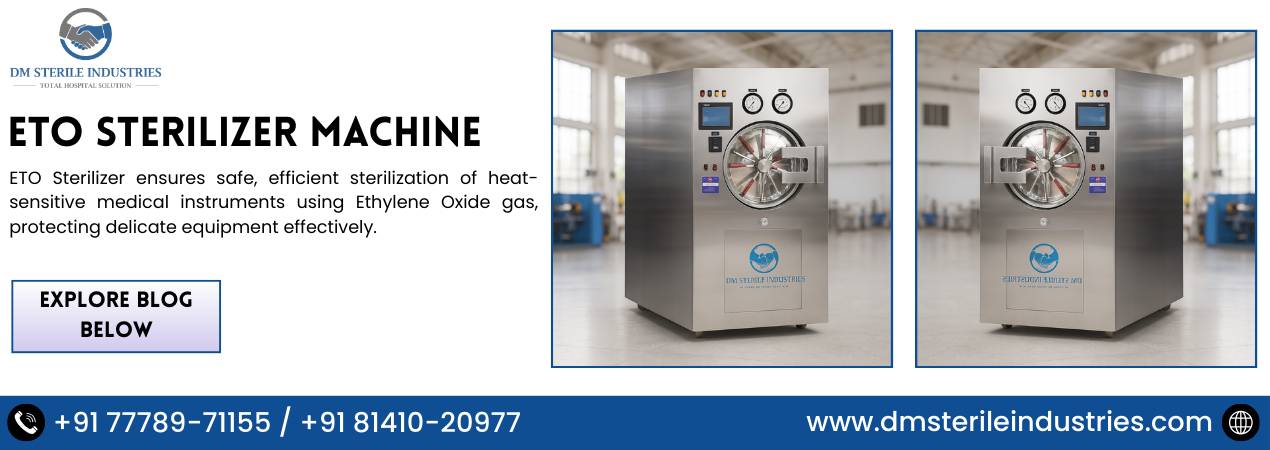Introduction to ETO55 Hospital ETO Sterilizer
The ETO55 Hospital ETO Sterilizer is a low-temperature ethylene oxide system engineered for safe, validated sterilization of heat- and moisture-sensitive instruments. Built for CSSD workflows, it delivers deep gas penetration, consistent cycle control, and traceable documentation. Hospitals, pharma units, and device manufacturers rely on its reliable microbial kill while preserving material integrity. Intelligent sensors, interlocks, and aeration safeguards support compliant, repeatable outcomes. With compact footprint and robust construction, ETO55 integrates smoothly into busy facilities, improving throughput and patient safety. For specifications, services, and installation support, explore DM Sterile Industries to match chamber size, load configuration, and monitoring options with your sterilization needs.
Working Principle and Process Flow for ETO55 Hospital ETO Sterilizer
ETO55 uses controlled humidity, temperature, and pressure to allow ethylene oxide molecules to diffuse into complex device geometries and inactivate microorganisms at the cellular level. A typical workflow includes preconditioning, exposure, and aeration. During exposure, precise mixing and circulation ensure uniform gas concentration across porous packaging and lumened instruments. Post-cycle aeration removes residuals to user-defined thresholds, protecting staff and patients. Integrated leak checks, vacuum pulses, and data logging deliver verified, reproducible cycles aligned with hospital SOPs and regulatory expectations. See detailed cycle options and validation guidance on the official website to configure process parameters for your load types.
Types of ETO55 Hospital ETO Sterilizer
- Single-door ETO55 chamber – compact, validated ETO sterilizer for CSSD rooms needing reliable penetration for delicate, heat-sensitive instruments and porous packaging.
- Double-door pass-through ETO55 – segregation-friendly layout enabling cleanroom workflows with unidirectional loading, minimizing cross-contamination between soiled and sterile zones.
- ETO55 with integrated aeration – built-in degassing allows post-sterilization aeration within the unit, streamlining turnaround while controlling residuals to accepted limits.
- ETO55 with catalytic abator – emission control accessory reduces ETO exhaust concentrations, supporting environmental compliance and safer operations around the sterilization area.
- Touchscreen PLC ETO55 variant – advanced HMI, programmable recipes, cycle data logging, and alarms for consistent results and easier staff training and audits.
Key Features and Specifications for the ETO55 Hospital ETO Sterilizer
- 55-liter stainless steel chamber with corrosion resistance for hospital duty and simplified cleaning between cycles.
- Low-temperature ETO process preserves material integrity of plastics, optics, electronics, and fine mechanical assemblies.
- Vacuum pulses and humidity control improve gas penetration across lumens and porous packaging for uniform sterilization.
- Safety interlocks, door sensors, and leak checks enhance operator protection and cycle integrity throughout operation.
- PLC touchscreen with recipe library, batch records, and USB export simplifies documentation and regulatory compliance.
Applications of ETO55 Hospital ETO Sterilizer
- Hospitals and surgical centers sterilize endoscopes, catheters, plastic instruments, and complex sets, achieving high sterility assurance without heat damage, while maintaining documented cycles that support infection control programs and accreditation requirements across departments.
- Pharmaceutical manufacturers process pre-packaged disposables, IV sets, syringe components, and implantable devices, retaining material properties and package seals, with parametric release supported by comprehensive monitoring, batch traceability, and validated aeration to meet regulatory expectations.
- Diagnostic and dental facilities treat temperature-sensitive instruments with lumens and joints, ensuring deep penetration through packaging, reduced turnaround, and consistent sterility levels that protect staff and patients during frequent, high-throughput clinical procedures.
- Medical device assemblers complete terminal sterilization before labeling and shipping, using repeatable cycles, standardized documentation, and emission controls that align with environmental policies, workplace safety guidance, and customer quality agreements in domestic and export markets.
Benefits of the ETO55 Hospital ETO Sterilizer
- Protects delicate materials by avoiding high heat and moisture, extending instrument lifespan, reducing repair costs, and enabling reliable reuse of advanced minimally invasive devices packaged in porous wraps or sealed medical pouches.
- Standardized, validated cycles with automated monitoring improve sterility assurance levels, reduce human error, and support audits, while data logging strengthens traceability, compliance reporting, and continuous quality improvement initiatives across hospital or manufacturing operations.
- Efficient workflows through integrated aeration options and programmable recipes streamline turnaround, optimize staffing, and balance throughput with safety, helping busy CSSDs achieve predictable schedules without compromising device performance or patient care priorities.
- Emission control accessories and leak detection measures reduce environmental impact and occupational exposure, aligning sterilization practices with sustainability targets, safety training, and local regulatory obligations for healthcare and life-science facilities.
Manufacturers & Suppliers in India
India hosts a diverse ecosystem of ETO sterilizer manufacturers, integrators, and service providers that support hospitals, diagnostic centers, and device makers with validated low-temperature solutions. Vendors typically offer chamber capacities from compact CSSD units to larger production systems, along with installation, IQ/OQ/PQ documentation, calibration, and staff training. Buyers should evaluate chamber construction, safety interlocks, gas handling, catalytic abatement, aeration capability, software records, and after-sales responsiveness. Shortlisted suppliers should also demonstrate local service teams, availability of consumables, and transparent lifecycle costs. Selecting partners with proven validation support, spare availability, and adherence to electrical, pressure, and environmental safety standards helps ensure dependable cycles and regulatory compliance across clinical and industrial settings.
Maintenance and Safety Tips
- Perform routine leak checks and gasket inspections before cycles to prevent unexpected emissions.
- Calibrate sensors, gauges, and recorders on schedule to maintain accurate process control.
- Clean chamber racks and drains after each batch to avoid residue accumulation and odors.
- Verify ventilation and abatement systems regularly for airflow, catalyst performance, and alarms.
- Train staff on PPE, handling procedures, and emergency response for ETO exposure incidents.
FAQs – ETO55 Hospital ETO Sterilizer
Contact Details
Talk to our specialists today for tailored solutions and fast assistance.

